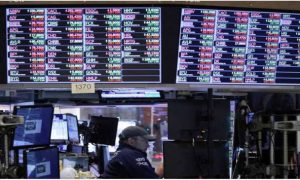Heading into the homestretch of 2024, we would call it a win if the markets said “meh” and called it a day. That isn’t to say there won’t be drama. And we see plenty of opportunities across the investing landscape, but if the markets end the year with a whimper near recent levels, we would gladly take it.
Consider the current juncture and rocky path ahead. The S&P 500 index is up an impressive 18% through August with superstars like Nvidia ahead 137%, even after a recent pullback. September, historically the worst month for stocks, may be especially volatile as markets await a decision on interest rates by the Federal Reserve; a quarter-point cut is almost certain, but much will hinge on the Fed’s messaging about inflation and potential for more easing.
Read More:- Wednesday’s big stock stories: What’s likely to move the market in the next trading session
The markets may not calm down in October, another historically dicey month, potentially exacerbated by anxiety over the election and policy changes coming out of Washington, D.C. Many strategists expect a year-end rally after the election dust settles. But even bulls like strategist Ed Yardeni—who has a “Roaring 2020s” as his base-case scenario—expect the S&P 500 to close the year around 5800, up about 3% from recent levels.
Bonds may get a modest tailwind from the Fed’s first rate cut since 2020, almost certainly arriving on Sept. 18 when the Fed’s Board of Governors concludes its meeting. But this may be the most telegraphed cut in modern history. And judging by the bond market’s terrific rally—with long-term Treasuries slightly beating even the tech-heavy Nasdaq 100 index since late April—there’s not much juice for yields to keep falling.
“How much of a rally is left in bonds, even if you expect a massive drop in rates?” says Michael Rosen, chief investment officer at Angeles Investments. The answer? Probably not much.
Some strategists are duly cautious. Phil Orlando at Federated Hermes, for instance, expects the S&P 500 to hit 6000 by the end of 2025, up about 7% from recent levels. Gene Goldman, chief investment officer at Cetera Investment Management, has the same 2025 target.
“The next few months may be challenging,” says Orlando, who nonetheless expects a relief rally after the election. “The path of least resistance is to take some chips off the table for stocks that have done phenomenally well over the past 18 months or so.”
Also Read– Are a Recession and Bear Market Imminent? A Virtually Flawless Predictive Indicator Weighs In.
None of this means that the bull market is dying. Nvidia, the bellwether for the artificial-intelligence trade, delivered solid quarterly results and hiked its revenue and profit forecasts, signaling that there’s still a long runway for chips, software, and related tech spending.
The market is also showing strength beyond tech. The S&P 500’s 12-month forward revenue forecast is up about 4% year to date, with all 11 sectors moving higher except energy, according to Yardeni. Earnings estimates are up about 9% year to date, with tech leading, ahead 17%. Momentum elsewhere includes higher earnings estimates for the consumer discretionary sector, up 11%; financials, ahead 10%; and real estate, up 9%.
Overall, S&P 500 earnings are expected to rise 5% in the third quarter and 16% in the fourth, according to consensus estimates. For 2025, Wall Street is penciling in 15% growth in S&P 500 profits.
Also Read– The New Medicare Part D Premiums Guide
Why so glum then? Partly because the market may already reflect much of the earnings growth, economic and productivity gains from AI, and a tailwind from rate cuts. The S&P 500 trades for more than 23 times forward estimates, above its historical average of 21.5. The mini-meltdown over the Japanese yen “carry trade” in August quickly reversed, but it may be a sign of the bull market’s fragility.
Where to invest now? To start, remember there is a wide universe beyond the Big Tech megacaps, and the AI trade appears to be loosening its grip; the S&P 500 closed flat the day after Nvidia’s earnings release, which prompted a 6% selloff in its stock.
If you own an index fund like the SPDR S&P 500 exchange-traded fund, you already have 30% in Apple, Microsoft, Nvidia, Alphabet, Amazon.com, and Meta Platforms. As Barron’s has long advised, it’s a good idea to branch out.
Also Read– After Powell gives his Jackson Hole speech, the markets may wish they’d never heard it
“The market concentration in just a few names is not going to go on in perpetuity,” says Kevin Walkush, co-manager of the Jensen Quality Growth ETF. “It sort of sounds like a bubble. We want to be positioned for when it pops.”
One of Walkush’s picks is animal-health company Zoetis. Walkush sees significant revenue potential for the company’s newer biologics drugs—injectable treatments such as Librela for dogs and Solensia for cats, which are both used to treat osteoarthritis pain. The stock has faced pressure over safety concerns about the drugs, though the company has said they are safe and effective. That could be the buying opportunity; shares are down nearly 7% this year. If the drugs overcome the safety concerns, they should help Zoetis hit Wall Street targets of 10% annualized earning growth over the next few years.
Chris Smith, a portfolio manager with Artisan Partners, is finding opportunities in aviation companies GE Aerospace and TransDigm. The companies make engines and other aviation components, with aftermarket sales expected to fuel lengthy revenue gains since planes need parts for decades. Both are benefiting from Boeing’s problems with its 737 MAX planes, causing airlines to keep older jets in service for longer.
Read More:- Stock rebound wanes as investors await US job data, Fed
GE Aerospace has been a rocket this year, up 71%, while Transdigm is ahead 35%. Smith thinks they can each keep rallying, despite valuations well above the market’s multiple.
Smith also sees a benefit from volatility and the coming rate cut: Invest in an exchange like Nasdaq, and data analytics companies S&P Global and Moody’s. Rising volumes and options activity should lift trading volumes and revenue for Nasdaq. Credit ratings and analytics companies S&P and Moody’s stand to gain from rate cuts, which are expected to fuel more corporate bond issuance. S&P Global and Moody’s should generate average earnings growth of 14% to 15% for the next few years, according to consensus forecasts.
For more-defensive plays, consider utilities and real estate investment trusts, or REITs. Joe Quinlan, chief strategist at Bank of America’s Merrill Lynch, likes both sectors, which are known for their dividends, yielding about 3%.
Utilities have been on a tear, thanks to surging demand for electricity to power data centers running AI. Companies like Talen Energy and Vistra are up more than 100% this year. But not all utilities are booming because of AI. The sector trades at about 19 times earnings, in line with its five-year average. The Utilities Select Sector SPDR ETF has big positions in diversified utilities like NextEra Energy, Southern Co., and Duke Energy.
REITs should also get a tailwind from falling rates, making their payouts more attractive than bonds. There’s also more to the sector than struggling commercial real estate, which has been hit by a decline in office occupancy rates. Vanguard Real Estate ETF covers the industry, including exposure to data centers and e-commerce with holdings like Equinix and Prologis. It’s ahead 9% this year and yields 3.5%.
Another place to look for bargains is in small-caps, an area that Quinlan likes, too. The SPDR Portfolio S&P 600 Small Cap ETF trades for 17 times forward estimates, a 30% discount to the S&P 500. Profits for the S&P Small Cap 600 index are estimated to jump almost 19% next year.
ALso Read– Nike, Ulta Beauty, Alibaba, Walmart, Tesla: Why These 5 Stocks Are On Investors’ Radars Today
Francis Gannon, co-chief investment officer with small-cap fund shop Royce Investment Partners, expects small-caps to benefit from rate cuts. He favors economically sensitive stocks, such as banks.
“This should be a nonrecessionary easing cycle,” he says. “Smaller banks should be in a good position once the Fed starts cutting.” Gannon also sees gains for industrials benefiting from a domestic “reshoring” manufacturing trend.
For a broad swing at both themes, consider the iShares Russell 2000 Value ETF. Financials and industrials account for 40% of its assets, including top holdings such as Florida regional bank SouthState, annuities provider Jackson Financial, railcar leasing firm GATX, and freight shipping company Matson.
In bonds, we wouldn’t expect big gains, but yields of 4% to 6% are likely to prevail as the Fed eases, which could also prop up prices a bit.
Read More:- Here’s Why Nvidia Stock Jumped Today
A safe bet is to stick with short-term bonds or funds like the iShares 1-3 Year Treasury Bond ETF. It yields 4% and would get a lift from rate cuts. Jackson Garton, co-chief investment officer of Makena Capital Management, likes two-year Treasuries and short-term bonds for both their yield and sensitivity to falling rates.
For a bit more yield, consider Payden Corporate Bond fund. “Corporations have been able to strengthen their balance sheets, thanks to stronger earnings. They’re not boosting their debt burdens, and they’ve been more prudent,” said Timothy Crawmer, a director and global credit strategist with Payden & Rygel, in a recent webcast.
Read More:- Stock Market Today: Stocks lower as markets fear new volatility wave
The fund has about half of its assets in BBB- and BB-rated bonds, hovering at the lowest end of investment grade and highest end of junk bonds. It yields 5% and has beaten the market average over the past 10 years.
UBS fixed-income strategists are also bullish on corporate credit, arguing in a recent report that Fed rate cuts “will pull money off the sidelines and the short end further out the credit curve.” Companies “are showing signs of resilience,” they note, and the surge in the VIX volatility index in early August “is not a harbinger of wider spreads,” referring to the difference in yield between corporate and Treasury bonds (with narrowing spreads a tailwind).
And what about the Magnificent Seven? Earnings for the group are expected to rise 30% this year and nearly 20% in 2025, so it would be a mistake to leave the group behind. Just be more selective.
Also Read– Markets are rebounding after Monday’s massive meltdown, making rate decisions harder for the Fed
Jensen’s Walkush owns Apple, Microsoft, and Alphabet. He thinks the trio has the best mix of valuations and growth prospects.
Bill Davis, a manager for the Hennessy Stance ESG ETF, owns those stocks for similar reasons. But he prefers Broadcom to Nvidia, for the former company’s cheaper valuation. Assuming that the AI wave stays strong, both stocks should do well, albeit in a choppy market along the way.





































